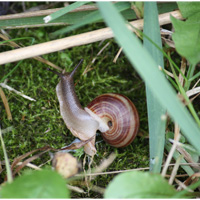Striped Whitelip
Scientific name: Webbhelix multilineata

Photo credit: Andrea Romero CC BY 4.0
Status
Endangered
“Endangered” means the species lives in the wild in Ontario but is facing imminent extinction or extirpation.
Date added to the Species at Risk in Ontario List
January 25, 2023
Read the assessment report (PDF)
What it looks like
The Striped Whitelip is a relatively large land snail, with the length of the adult shell reaching 2 to 2.5 cm. The shell is thin and slightly flattened with shallow grooves on the surface, and a white lip on the aperture (the opening of the snail shell where the animal’s body emerges) in adults. The shell has a few to multiple russet-coloured spiral bands, present on a pale-yellow coloured background. The body is light to dark grey.
Where it lives
The Striped Whitelip inhabits wet, lowland forest at the margins of periodically flooded areas (like marshlands or swamps), or in continuously wet areas. This species inhabits areas with plenty of leaves and woody materials, such as logs and bark. The damp woods that the Striped Whitelip inhabits are typically dominated by the following trees:
- oak
- hickory
- maple
The Striped Whitelip is distributed across eastern North American from Indiana to Kansas. Ontario represents the northern limit of the species’ range.
Where it’s been found in Ontario
The current range of the Striped Whitelip in Ontario includes sites from two counties (Essex and Lambton), where live specimens or shells have recently been found. The species is known to be extant (presently located) in:
- Fish Point Provincial Nature Reserve and Stone Road Alvar on Pelee Island
- on the mainland in Bickford Oak Woods Conservation Reserve, Walpole Island
- Point Pelee National Park
The known number of occupied sites have recently been reduced from 12 to seven. This is because it has not been seen alive during the last 20 years at several of the sites where it had been previously known to occur, despite repeated and recent searches.
What threatens it
The Striped Whitelip is directly threatened by effects of climate change, including extreme weather events, shifts in habitat availability and extreme temperatures or prolonged drought.
Human alteration of habitat and other human activity, such as recreation, also threaten the Striped Whitelip. Trampling of this species can happen when the species forages on trails during ephemeral (temporary) wet events. Natural system modifications, such as controlled burns, may also negatively impact the species. Other threats to the species include invasive species and fire suppression.
Action we are taking
This species and its habitat are protected under Ontario’s Endangered Species Act, 2007.
The ESA also requires the preparation of recovery guidance for endangered species such as Striped Whitelip to guide recovery efforts for the species in Ontario.
All species listed on the Species at Risk in Ontario List may be eligible for consideration for government funding through the Species at Risk Stewardship Program.
What you can do
Report a sighting
Submit your observations of species at risk to the Natural Heritage Information Centre (NHIC), which is Ontario’s conservation data centre. Join the “(NHIC) Rare Species of Ontario” project in iNaturalist to make submitting your observations quick and easy.
Volunteer
Volunteer with species at risk programs, such as community science surveys, through your local nature club, a provincial park or other conservation organizations.
Be a good steward
- Private landowners have a very important role to play in species recovery. If you find species at risk on your land, you may be eligible for stewardship programs that support the protection and recovery of species at risk and their habitats, such as the Species at Risk Stewardship Program.
- Invasive species seriously threaten many of Ontario’s species at risk. To learn what you can do to help reduce the threat of invasive species, visit:
Report illegal activity
Report any illegal activity related to species at risk to
Quick facts
- The Striped Whitelip is considered a specialist (a species requiring specific habitat and/or food resources) on lowland, wet forest.
- Striped Whitelip in Canada only occurs in the Carolinian Forest Region, at the northern limit of the species’ global range.
- The hibernation of Striped Whitelip probably extends from early October until mid-April. The exact timing is expected to vary depending on conditions each year.